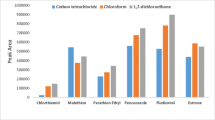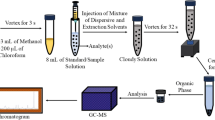Abstract
A sensitive and reliable analytical method for the simultaneous determination of seven endocrine disrupting compounds (EDCs) in water was developed and validated. This quantification method is based on solid phase extraction (SPE) followed by a derivatization with BSTFA and finally the seven EDCs were analyzed by gas chromatography–mass spectrometry (GC–MS). A 23 factorial design was used to optimize the extraction procedure. Three factors, namely sample volume, elution solvent, and pH of sample were investigated using Doehlert matrix. The optimal conditions of SPE method were: HLB cartridge, 540 mL of water sample with a pH 8 and 10 mL of mixture of ethyl acetate/acetone with a ratio of (55/45, v/v) in the elution step. For validation of the technique, accuracy, precision, detection and quantification limits, linearity, sensibility and selectivity were determined. Extraction recovery of these seven EDCs were above 90% with relative standard deviations (RSD) ≤ 2%. The method limit of detection and limit of quantification were in the range of 0.33–3.33 and 1–10 ng/L, respectively.




Similar content being viewed by others
References
Aydin E, Talinli I (2013) Analysis, occurrence and fate of commonly used pharmaceuticals and hormones in the Buyukcekmece Watershed, Turkey. Chemosphere 90:2004–2012. doi:10.1016/j.chemosphere.2012.10.074
Ballesteros-Gómez A, Rubio S, Pérez-Bendito D (2009) Analytical methods for the determination of bisphenol A in food. J Chromatogr A 1216:449–469. doi:10.1016/j.chroma.2008.06.037
Belhaj D, Baccar R, Jaabiri I et al (2015) Fate of selected estrogenic hormones in an urban sewage treatment plant in Tunisia (North Africa). Sci Total Environ 505:154–160. doi:10.1016/j.scitotenv.2014.10.018
Evgenidou EN, Konstantinou IK, Lambropoulou DA (2015) Occurrence and removal of transformation products of PPCPs and illicit drugs in wastewaters: a review. Sci Total Environ 505:905–926. doi:10.1016/j.scitotenv.2014.10.021
Facco JF, Martins ML, Bernardi G et al (2015) Optimization and validation of a multiresidue method for pesticide determination in maize using gas chromatography coupled to tandem mass spectrometry. Anal Methods 7:359–365. doi:10.1039/C4AY01970A
Friedrich MT, Martins ML, Prestes OD, Zanella R (2016) Use of factorial design in the development of multiresidue method for determination of pesticide residues in wheat by liquid chromatography-tandem mass spectrometry. Food Anal Methods 9:2541–2551. doi:10.1007/s12161-016-0447-0
Gao L, Sun L, Wan S et al (2013) Degradation kinetics and mechanism of emerging contaminants in water by dielectric barrier discharge non-thermal plasma: the case of 17β-Estradiol. Chem Eng J 228:790–798. doi:10.1016/j.cej.2013.05.079
Gorga M, Petrovic M, Barceló D (2013) Multi-residue analytical method for the determination of endocrine disruptors and related compounds in river and waste water using dual column liquid chromatography switching system coupled to mass spectrometry. J Chromatogr A 1295:57–66. doi:10.1016/j.chroma.2013.04.028
Grover DP, Zhang ZL, Readman JW, Zhou JL (2009) A comparison of three analytical techniques for the measurement of steroidal estrogens in environmental water samples. Talanta 78:1204–1210. doi:10.1016/j.talanta.2008.12.049
Guedes-Alonso R, Sosa-Ferrera Z, Santana-Rodríguez JJ (2013) Simultaneous determination of hormonal residues in treated waters using ultrahigh performance liquid chromatography-tandem mass spectrometry. J Anal Methods Chem 2013:1–8. doi:10.1155/2013/210653
Hibbert DB (2012) Experimental design in chromatography: a tutorial review. J Chromatogr B 910:2–13. doi:10.1016/j.jchromb.2012.01.020
Huang B, Pan X-J, Wan X et al (2011) Simultaneous determination of steroid endocrine disrupting chemicals in water by solid phase extraction-derivatization- gas chromatographic-mass spectrometry. Chin J Anal Chem 39:449–454. doi:10.1016/S1872-2040(10)60431-8
Jiang J-Q, Zhou Z, Sharma VK (2013) Occurrence, transportation, monitoring and treatment of emerging micro-pollutants in waste water—a review from global views. Microchem J 110:292–300. doi:10.1016/j.microc.2013.04.014
Jin W, Huang B, Wang B et al (2013) Simultaneous determination of androgens and progestogen in surface water and sediment by gas chromatography-mass spectrometry. Chin J Anal Chem 41:205–209. doi:10.1016/S1872-2040(13)60628-3
Karnjanapiboonwong A, Suski JG, Shah AA, Cai Q, Morse AN, Anderson TA (2011) Occurrence of PPCPs at a wastewater treatment plant and in soil and groundwater at a land application site. Water Air Soil Pollut 216:257–273. doi:10.1007/s11270-010-0532-8
Kemmerich M, Rizzetti TM, Martins ML et al (2015) Optimization by central composite design of a modified QuEChERS method for extraction of pesticide multiresidue in sweet pepper and analysis by ultra-high-performance liquid chromatography–tandem mass spectrometry. Food Anal Methods 8:728–739. doi:10.1007/s12161-014-9951-2
Labadie P, Budzinski H (2005) Determination of steroidal hormone profiles along the Jalle d’Eysines River (near Bordeaux, France). Environ Sci Technol 39:5113–5120. doi:10.1021/es048443g
Latrous El Atrache L, Ben Sghaier R, Bejaoui Kefi B et al (2013) Factorial design optimization of experimental variables in preconcentration of carbamates pesticides in water samples using solid phase extraction and liquid chromatography–electrospray-mass spectrometry determination. Talanta 117:392–398. doi:10.1016/j.talanta.2013.09.032
Laurenson JP, Bloom RA, Page S, Sadrieh N (2014) Ethinyl estradiol and other human pharmaceutical estrogens in the aquatic environment: a review of recent risk Assessment Data. AAPS J 16:299–310. doi:10.1208/s12248-014-9561-3
Lee I-S, Lee S-H, Oh J-E (2010) Occurrence and fate of synthetic musk compounds in water environment. Water Res 44:214–222. doi:10.1016/j.watres.2009.08.049
Munaretto JS, Ferronato G, Ribeiro LC et al (2013) Development of a multiresidue method for the determination of endocrine disrupters in fish fillet using gas chromatography–triple quadrupole tandem mass spectrometry. Talanta 116:827–834. doi:10.1016/j.talanta.2013.07.047
Net S, Rabodonirina S, Sghaier RB et al (2015) Distribution of phthalates, pesticides and drug residues in the dissolved, particulate and sedimentary phases from transboundary rivers (France–Belgium). Sci Total Environ 521–522:152–159. doi:10.1016/j.scitotenv.2015.03.087
Nie Y, Qiang Z, Zhang H, Ben W (2012) Fate and seasonal variation of endocrine-disrupting chemicals in a sewage treatment plant with A/A/O process. Sep Purif Technol 84:9–15. doi:10.1016/j.seppur.2011.01.030
Nielsen S (2014) Food analysis. Springer Science & Business Media, New York
Rabodonirina S, Net S, Ouddane B et al (2015) Distribution of persistent organic pollutants (PAHs, Me-PAHs, PCBs) in dissolved, particulate and sedimentary phases in freshwater systems. Environ Pollut 206:38–48. doi:10.1016/j.envpol.2015.06.023
Reinen J, Suter MJ-F, Vögeli AC et al (2010) Endocrine disrupting chemicals—linking internal exposure to vitellogenin levels and ovotestis in Abramis brama from Dutch surface waters. Environ Toxicol Pharmacol 30:209–223. doi:10.1016/j.etap.2010.07.004
Rice SL, Hale RC (2009) Parameters for ultra-performance liquid chromatographic/tandem mass spectrometric analysis of selected androgens versus estrogens in aqueous matrices. Anal Chem 81:6716–6724. doi:10.1021/ac900134m
Sghaier RB, Net S, Ghorbel-Abid I et al (2017) Simultaneous detection of 13 endocrine disrupting chemicals in water by a combination of SPE-BSTFA derivatization and GC–MS in transboundary rivers (France–Belgium). Water Air Soil Pollut. doi:10.1007/s11270-016-3195-2
Sim W-J, Lee J-W, Oh J-E (2010) Occurrence and fate of pharmaceuticals in wastewater treatment plants and rivers in Korea. Environ Pollut 158:1938–1947. doi:10.1016/j.envpol.2009.10.036
Stafiej A, Pyrzynska K, Regan F (2007) Determination of anti-inflammatory drugs and estrogens in water by HPLC with UV detection. J Sep Sci 30:985–991. doi:10.1002/jssc.200600433
Sun Y, Huang H, Sun Y et al (2014) Occurrence of estrogenic endocrine disrupting chemicals concern in sewage plant effluent. Front Environ Sci Eng 8:18–26. doi:10.1007/s11783-013-0573-5
Thurman EM, Writer JH, Ferrer I (2013) Injection port derivatization for GC/MS–MS. In: Comprehensive analytical chemistry. Elsevier, pp 115–141
Vandenberg LN, Colborn T, Hayes TB et al (2012) Hormones and endocrine-disrupting chemicals: low-dose effects and nonmonotonic dose responses. Endocr Rev 33:378–455. doi:10.1210/er.2011-1050
Xu Y, Xu N, Llewellyn NR, Tao H (2014) Occurrence and removal of free and conjugated estrogens in wastewater and sludge in five sewage treatment plants. Env Sci Process Impacts 16:262–270. doi:10.1039/C3EM00199G
Yang S, Hai FI, Nghiem LD et al (2013) Understanding the factors controlling the removal of trace organic contaminants by white-rot fungi and their lignin modifying enzymes: a critical review. Bioresour Technol 141:97–108
Yang Y, Cao X, Zhang M, Wang J (2015) Occurrence and distribution of endocrine-disrupting compounds in the Honghu Lake and East Dongting Lake along the Central Yangtze River, China. Environ Sci Pollut Res 22:17644–17652. doi:10.1007/s11356-015-4980-y
Yu Y, Wu L (2015) Determination and occurrence of endocrine disrupting compounds, pharmaceuticals and personal care products in fish (Morone saxatilis). Front Environ Sci Eng 9:475–481. doi:10.1007/s11783-014-0640-6
Zhang R, Li N, Wang C et al (2011) Ionic liquid foam floatation coupled with solid phase extraction for separation and determination of hormones by high-performance liquid chromatography. Anal Chim Acta 704:98–109. doi:10.1016/j.aca.2011.08.016
Zoeller RT, Brown TR, Doan LL et al (2012) Endocrine-disrupting chemicals and public health protection: a Statement of Principles from The Endocrine Society. Endocrinology 153:4097–4110. doi:10.1210/en.2012-1422
Acknowledgements
The authors are grateful for the support provided by CPER CLIMBIO project. We acknowledge the financial support from the Tunisian Minister of Higher Education and Scientific Research, which provided a PhD scholarship for Rafika Ben Sghaier.
Author information
Authors and Affiliations
Corresponding author
Rights and permissions
About this article
Cite this article
Ben Sghaier, R., Tlili, I., Latrous El Atrache, L. et al. A Combination of Factorial Design, Off-line SPE and GC–MS Method for Quantifying Seven Endocrine Disrupting Compounds in Water. Int J Environ Res 11, 613–624 (2017). https://doi.org/10.1007/s41742-017-0054-y
Received:
Revised:
Accepted:
Published:
Issue Date:
DOI: https://doi.org/10.1007/s41742-017-0054-y




